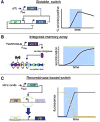Synthetic Biology and the Gut Microbiome
- PMID: 28976641
- PMCID: PMC5882594
- DOI: 10.1002/biot.201700159
Synthetic Biology and the Gut Microbiome
Abstract
The gut microbiome plays a crucial role in maintaining human health. Functions performed by gastrointestinal microbes range from regulating metabolism to modulating immune and nervous system development. Scientists have attempted to exploit this importance through the development of engineered probiotics that are capable of producing and delivering small molecule therapeutics within the gut. However, existing synthetic probiotics are simplistic and fail to replicate the complexity and adaptability of native homeostatic mechanisms. In this review, the ways in which the tools and approaches of synthetic biology have been applied to improve the efficacy of therapeutic probiotics, and the ways in which they might be applied in the future is discussed. Simple devices, such as a bistable switches and integrase memory arrays, have been successfully implemented in the mammalian gut, and models for targeted delivery in this environment have also been developed. In the future, it will be necessary to introduce concepts such as logic-gating and biocontainment mechanisms into synthetic probiotics, as well as to expand the collection of relevant biosensors. Ideally, this will bring us closer to a reality in which engineered therapeutic microbes will be able to accurately diagnose and effectively respond to a variety of disease states.
Keywords: biosensors; engineered microbes; engineered probiotics; microbiome therapeutics.
© 2017 WILEY-VCH Verlag GmbH & Co. KGaA, Weinheim.
Conflict of interest statement
The authors declare no financial or commercial conflicts of interest.
Figures



Similar articles
-
Artificial intelligence and synthetic biology approaches for human gut microbiome.Crit Rev Food Sci Nutr. 2022;62(8):2103-2121. doi: 10.1080/10408398.2020.1850415. Epub 2020 Nov 30. Crit Rev Food Sci Nutr. 2022. PMID: 33249867 Review.
-
Engineering Diagnostic and Therapeutic Gut Bacteria.Microbiol Spectr. 2017 Oct;5(5):10.1128/microbiolspec.bad-0020-2017. doi: 10.1128/microbiolspec.BAD-0020-2017. Microbiol Spectr. 2017. PMID: 29052539 Free PMC article. Review.
-
Synthetic Biology-Driven Microbial Therapeutics for Disease Treatment.J Microbiol Biotechnol. 2024 Oct 28;34(10):1947-1958. doi: 10.4014/jmb.2407.07004. Epub 2024 Aug 19. J Microbiol Biotechnol. 2024. PMID: 39233526 Free PMC article. Review.
-
Synthetic Biology and Engineered Live Biotherapeutics: Toward Increasing System Complexity.Cell Syst. 2018 Jul 25;7(1):5-16. doi: 10.1016/j.cels.2018.06.008. Cell Syst. 2018. PMID: 30048620 Review.
-
Engineering Microbial Living Therapeutics: The Synthetic Biology Toolbox.Trends Biotechnol. 2019 Jan;37(1):100-115. doi: 10.1016/j.tibtech.2018.09.005. Epub 2018 Oct 11. Trends Biotechnol. 2019. PMID: 30318171 Review.
Cited by
-
Recent advances in genetic tools for engineering probiotic lactic acid bacteria.Biosci Rep. 2023 Jan 31;43(1):BSR20211299. doi: 10.1042/BSR20211299. Biosci Rep. 2023. PMID: 36597861 Free PMC article.
-
Synthetic Biology─High Time to Deliver?ACS Synth Biol. 2023 Jun 16;12(6):1579-1582. doi: 10.1021/acssynbio.3c00238. ACS Synth Biol. 2023. PMID: 37322887 Free PMC article.
-
Synthetic biology for space exploration.NPJ Microgravity. 2025 Jul 12;11(1):41. doi: 10.1038/s41526-025-00488-7. NPJ Microgravity. 2025. PMID: 40651964 Free PMC article. Review.
-
Probiotics an emerging therapeutic approach towards gut-brain-axis oriented chronic health issues induced by microplastics: A comprehensive review.Heliyon. 2024 May 28;10(11):e32004. doi: 10.1016/j.heliyon.2024.e32004. eCollection 2024 Jun 15. Heliyon. 2024. PMID: 38882279 Free PMC article. Review.
-
Evaluation of existing guidelines for their adequacy for the food and feed risk assessment of microorganisms obtained through synthetic biology.EFSA J. 2022 Aug 16;20(8):e07479. doi: 10.2903/j.efsa.2022.7479. eCollection 2022 Aug. EFSA J. 2022. PMID: 35991959 Free PMC article.
References
-
- Sekirov I, Russell SL, Antunes LCM, Finlay BB, et al. Gut microbiota in health and disease. Physiol Rev. 2010;90:859–904. - PubMed
Publication types
MeSH terms
Grants and funding
LinkOut - more resources
Full Text Sources
Other Literature Sources

